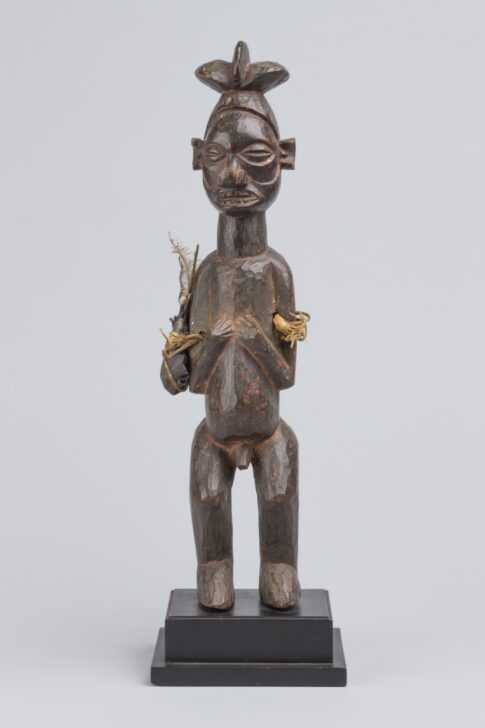Male Figure
Yaka; Suku

Description
For decades scholars have classified African artworks according to the so-called ethnic groups that made them. Figures such as these would have been categorized as made by either the Yaka or the Suku peoples of the Democratic Republic of the Congo, amongst whom they were collected in the first half of the twentieth century. At the time, however, the Kwango region in Southern Congo was made up of a complex intersection of languages, kingdoms, and cultures that traded goods, interacted socially, and found inspiration in each other’s artistic traditions. Yaka artists were strongly influenced by their Suku, Nkanu, and Teke neighbors, and Yaka ritual healers and a uent chiefs actively collected pieces made by them, especially those they found aesthetically pleasing and visually powerful.
The attribution of this figure to a particular “ethnic” group was based on narrow conceptions of Central Africa that originated in the colonial period, when European nations artificially partitioned the region into distinct ethnic areas. More recent scholarship recognizes that cultural practices were not monolithic, but widely shared among groups, as evidenced by the transfer of artworks and free flow of artistic ideas, and that their makers are not so easily identified.
Subject Matter:
The Yaka and Suku peoples of the Democratic Republic of Congo and Angola, along with neighboring cultural groups, have a history of economic, social, and artistic interaction. As there are many stylistic similarities between Yaka and Suku figures, it is not possible to attribute this figure to one group or the other.
Both peoples also share roughly 20 charm-curse institutions. A person can approach a diviner of one of the institutions if they have been wronged to have a curse placed on the individual that wronged them. Five of the charm-curse institutions use carved figures, including mbaambi, ndzasi, khosi, mbwoolu-tyso, and ngoombu. Many of the figures share similar poses such as both hands clutched to the chest, which may refer to a person confessing guilt or swearing secrecy. Some figures also feature headgear worn by Yaka and Suku leaders. The projecting crests of this figure are similar to those of a bweni hat, worn as a symbol of authority by land chiefs.
It is also possible this is a phuungu figure, a carved human image with packets of sticks, feathers, or bamboo. Usually owned by head of a patrilineal kin group, the figure may pass from father to son. The need for this kind of figure is designated by a diviner. Such figures functioned to protect against witches or other enemies in the community.
References Cited:
Bourgeois, Arthur P. 1979. "Mbwoolo Sculpture of the Yaka." African Arts 12, no. 3: 58-96.
Bourgeois, Arthur P. 1982. “Yaka and Suku Leadership Headgear.” African Arts 15, no. 3: 30-35+92.
Bourgeois, A. P. 1985. The Yaka and Suku. Leiden: Brill.
Physical Description:
Standing male figure with his hands on his chest. Cord and fiber are wrapped around one arm and a bag containing feathers and sticks is tied to the other arm.
Usage Rights:
If you are interested in using an image for a publication, please visit https://umma.umich.edu/request-image/ for more information and to fill out the online Image Rights and Reproductions Request Form.